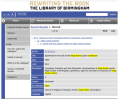superdad3
master brummie
Kings Norton Workhouse - a note
Prior to 1834, looking after the poor was the responsibility of the Parish partly by providing a Workhouse.
KN probably had a workhouse from about 1729 and from 1803 a building on the south side of the green was used.
In 1836 the Kings Norton Poor Law Union was formed. This included the 5 parishes of Beoley, Northfield, Kings Norton, Edgbaston and Harborne [including Smethwick}. Initially existing workhouses were used but in 1870 the new Union workhouse was built on Raddlebarn Road [originally called Workhouse Lane] and was known as the Kings Norton Union Workhouse until the 1920s when it became known as the Selly Oak Infirmary.
In 1911 [after the Greater Birmingham Act] Kings Norton Union was amalgamated with Birmingham and Aston Unions to create the enlarged Birmingham Union.
Civil registration was introduced by the Civil Registration Act 1836 to take effect from 1837. The Registration Districts
used the same boundaries as the existing poor law unions and this can be a source of confusion when researching ancesters. A birth certificate may well state born in "Kings Norton" but that is the registration district. They may well have been born in Kings Norton but equally it could have been Northfield, Edgbaston or even Smethwick!
Peter Higginbotham's brilliant site at https://www.workhouses.org.uk/KingsNorton/ has already been mentioned on this thread and gives a facinating account with many pictures - well worth a read.
Prior to 1834, looking after the poor was the responsibility of the Parish partly by providing a Workhouse.
KN probably had a workhouse from about 1729 and from 1803 a building on the south side of the green was used.
In 1836 the Kings Norton Poor Law Union was formed. This included the 5 parishes of Beoley, Northfield, Kings Norton, Edgbaston and Harborne [including Smethwick}. Initially existing workhouses were used but in 1870 the new Union workhouse was built on Raddlebarn Road [originally called Workhouse Lane] and was known as the Kings Norton Union Workhouse until the 1920s when it became known as the Selly Oak Infirmary.
In 1911 [after the Greater Birmingham Act] Kings Norton Union was amalgamated with Birmingham and Aston Unions to create the enlarged Birmingham Union.
Civil registration was introduced by the Civil Registration Act 1836 to take effect from 1837. The Registration Districts
used the same boundaries as the existing poor law unions and this can be a source of confusion when researching ancesters. A birth certificate may well state born in "Kings Norton" but that is the registration district. They may well have been born in Kings Norton but equally it could have been Northfield, Edgbaston or even Smethwick!
Peter Higginbotham's brilliant site at https://www.workhouses.org.uk/KingsNorton/ has already been mentioned on this thread and gives a facinating account with many pictures - well worth a read.

